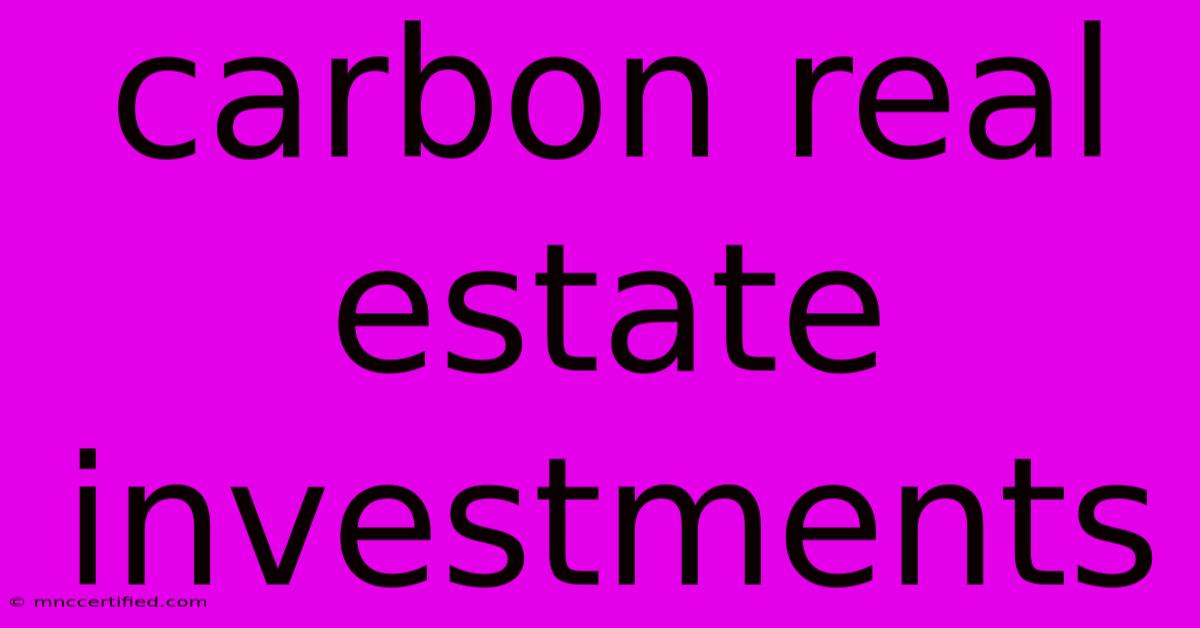Carbon Real Estate Investments

Table of Contents
Carbon Real Estate Investments: A Growing Market
The real estate market is constantly evolving, and a new sector is gaining significant traction: carbon real estate investments. This isn't about buying properties made of carbon fiber (though that's a fascinating niche!), but rather investing in properties based on their carbon footprint and future-proofing potential. This burgeoning area offers exciting opportunities for investors who are environmentally conscious and keen on securing long-term, sustainable returns.
Understanding Carbon Real Estate
Unlike traditional real estate investments that focus primarily on location, size, and rental income, carbon real estate investments consider the environmental impact of a property. This includes factors such as:
-
Energy Efficiency: Properties with high energy efficiency ratings (e.g., LEED certification) command higher valuations and lower operating costs, making them attractive investments. Investing in properties with solar panels or other renewable energy sources is a key aspect.
-
Carbon Emissions: Investors are increasingly scrutinizing a building's carbon footprint, from construction materials to ongoing operational emissions. Properties with lower emissions are favored, reflecting a growing market demand for sustainable living.
-
Embodied Carbon: This refers to the carbon emissions associated with the materials used to build a structure. Properties built with sustainable and recycled materials have a lower embodied carbon footprint and are therefore more appealing to environmentally conscious investors.
-
Future-Proofing: Regulations around carbon emissions are tightening globally. Investing in properties that already meet or exceed these standards ensures long-term value and reduces the risk of future retrofitting costs.
-
Green Building Certifications: Seeking properties with certifications like LEED (Leadership in Energy and Environmental Design), BREEAM (Building Research Establishment Environmental Assessment Method), or EDGE (Excellence in Design for Greater Efficiencies) can significantly improve the investment's value and appeal.
Types of Carbon Real Estate Investments
Several investment options fall under the umbrella of carbon real estate:
- Direct Property Ownership: Purchasing energy-efficient or green-certified buildings outright.
- REITs (Real Estate Investment Trusts): Investing in publicly traded companies specializing in sustainable real estate.
- Green Bonds: Financing projects focused on building or retrofitting green buildings.
- Carbon Offset Projects: Investing in projects that reduce carbon emissions, often linked to real estate developments.
Why Invest in Carbon Real Estate?
The reasons to consider carbon real estate investments are compelling:
- Strong Financial Returns: Energy-efficient properties often translate to lower operating costs and higher rental yields, potentially exceeding traditional investment returns.
- Environmental Responsibility: Investing in carbon-conscious properties aligns with environmental, social, and governance (ESG) principles, allowing investors to contribute to a sustainable future.
- Reduced Risk: Stringent regulations around carbon emissions are likely to become more prevalent, potentially devaluing properties that fail to meet sustainability standards. Investing in green properties mitigates this risk.
- Growing Demand: The demand for sustainable living is increasing, driving up the value of green properties and making them attractive long-term investments.
- Positive Social Impact: Investing in carbon real estate contributes to a healthier environment and promotes sustainable development within communities.
Challenges and Considerations
While the potential benefits are significant, investors should be aware of some challenges:
- Higher Initial Costs: Green building materials and technologies can be more expensive upfront.
- Limited Supply: The supply of existing green-certified properties may be limited in certain markets.
- Lack of Standardized Metrics: The measurement and assessment of carbon footprints can vary, making it crucial to conduct thorough due diligence.
- Technological Advancements: The rapid pace of technological advancements in green building technologies requires staying updated on the latest innovations.
The Future of Carbon Real Estate
The carbon real estate market is poised for significant growth. Increasing awareness of climate change, stricter environmental regulations, and growing investor interest in ESG factors will continue to drive demand. Investors who embrace this emerging sector are well-positioned to capitalize on its potential and contribute to a more sustainable future. Thorough research, due diligence, and expert advice are crucial for successful navigation of this evolving market. The future is green, and the future of real estate is undoubtedly intertwined with its sustainability.

Thank you for visiting our website wich cover about Carbon Real Estate Investments. We hope the information provided has been useful to you. Feel free to contact us if you have any questions or need further assistance. See you next time and dont miss to bookmark.
Featured Posts
-
Liverpool Game Six Real Madrid Injuries
Nov 28, 2024
-
Slot Recalls Klopp Plan Liverpool Vs Madrid
Nov 28, 2024
-
Parachute Clue In Unsolved D B Case
Nov 28, 2024
-
Thanksgiving 2024 Hours Open Closed
Nov 28, 2024
-
Crime At Groucho Club Club Now Closed
Nov 28, 2024